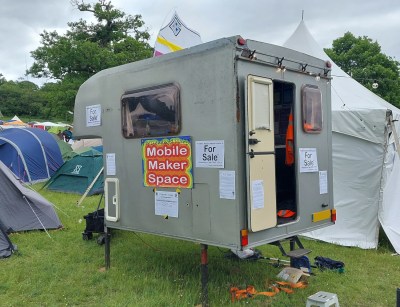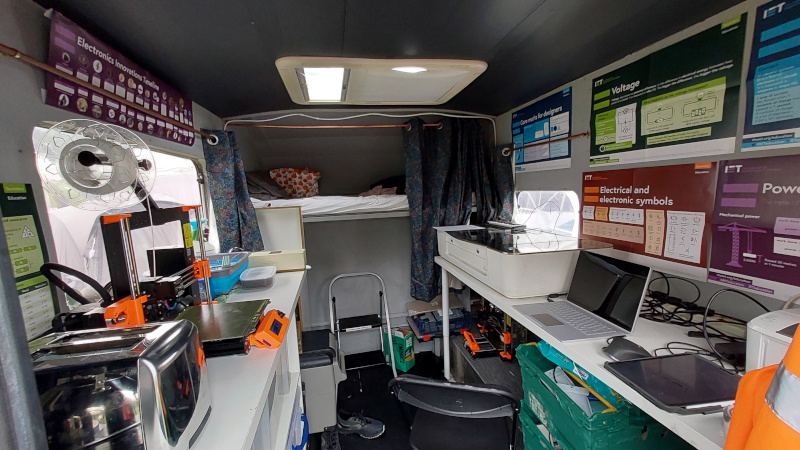Wandering round the field at EMF Camp, our eye was caught by an unusual sight, at least to European eyes. The type of campervan body which sits on the back of a pickup truck is not particularly common on this side of the Atlantic, but there one was, fitted out as a mobile makerspace. If that wasn’t enough, this one is for sale.
 Here at Hackaday we’re neither estate agents or in the want-ads business, so we’re unaccustomed to property promotion. We’re still not immune to the attraction of a portable makerspace to take to events though, and this one provides a very practical basis. It started life as what Brits call a Luton van body, a box van, and inside it’s gained a small kitchen, benches and shelves either side, and up in the space over the cab, a double bed. Sadly the laser cutter and 3D printers aren’t included.
Here at Hackaday we’re neither estate agents or in the want-ads business, so we’re unaccustomed to property promotion. We’re still not immune to the attraction of a portable makerspace to take to events though, and this one provides a very practical basis. It started life as what Brits call a Luton van body, a box van, and inside it’s gained a small kitchen, benches and shelves either side, and up in the space over the cab, a double bed. Sadly the laser cutter and 3D printers aren’t included.
If you live in Southern England and you want to be the envy of everyone at your next hacker camp, an email to richjmaynard at gmail dot com with a sensible offer might secure it. We would be first in the queue if we had the space, because what Wrencher scribe wouldn’t want an office like this!

















I love the use of copper plumbing pipe for a curtain rail, seems very appropriate.
Missed opportunity though to have a toaster that both makes toast and reflows PCBs.
Don’t want to be all safety sally, but I wouldn’t reflow PCB’s inside and I really wouldn’t use a toaster that was used to reflow PCB’s to prepare food. Lead poisoning is one of the possibilities of the downfall of the Roman empire.
Good job we’re lead free then.
Though I’d still not use the same toaster oven for PCB and food work.
Sorry for any confusion but I wasn’t being serious about the toaster, it’s just that a toaster was the most prominent item in the photo of a maker space! Poor attempt at humour.
The romans ate “sugar of lead”, which is a sweet-tasting lead salt. Metallic lead is not readily bioavailable, and at soldering temperatures does not vaporize. There is little risk of lead poisoning from a reflow oven. The biggest potential hazard is from the flux, and that’s mostly just an inhalation risk.
Lead acetate. Didn’t know the Romans ingested it as a condiment. Hmm…with a pinch of Paris Green?
I think that toaster is used for making toast.
Is this thing actually a common concept then? I’ve seen the odd occasion folks build similar stuff for their pickup/van/landrover that isn’t meant to be permanent. But usually its not meant to just jump off, and this thing seems to be free standing on pretty thin legs in a field, so presumably wasn’t removed with much mechanical aid and is tough enough to be removed while fully loaded inside.
Which makes me wonder how you manage to get it on and off the truck as well. Seems like it would have to be heavy and awkward and I don’t see any obvious mounting points for a lifting jack, winch or whatever. Also at the size it has to be it must require a very rare size of pickup at least in the UK, where pickups are rare anyway and ones with huge load bed rarer still.
It is an interesting idea though. One i could see falling down the rabbit hole after you build the first, and then find you want lots of little quality of life improvements for the rest. Though in the UK as you are not so likely to have a pickup truck I think you’d be putting it on wheels and towing it, a caravan turned mobile maker space may not be as unusual, but it is a lot more practical than a ‘portable’ space you can’t actually move.
This one appears to mount to a box truck, but “slide ins” that fit in a pickup truck are common in the US. My guess is the legs would serve as lifting jacks: they may have electric or hydraulic power or could be hand cranked screw mechanisms. They would lift it off the chassis when dropping off and hold it high enough to pull the truck back under it to pick it up.
Looks like the front legs are too far forward for them to be used to lift it onto the truck to me – seems like they are right at that leading corner which would make it very hard to get the truck under it at all before crashing the legs. Though I guess if the truck is a fair bit narrower than the legs that would work, and that seems to be common for ‘slide ins’ (a term I’d never heard of before today). However if that is the case there doesn’t seem to be much to register it to the truck bed or hold it down in this case, which makes me curious how this one is supposed to work.
The thin legs/jacks do work well, as evidenced by the common usage here in The States. Once the “camper” is inside the truck bed. The legs are folded up or removed and clamps and often turnbuckles are used to secure it to the truck. I don’t know how stable they are when removed from the truck, but if in a spot sheltered from strong winds, they remain that way until the next camping season.
Yeah that bit I get in concept, having had a skim though the offerings available to USA pickup owners its very clear how they usually work. And I don’t think those legs are too small to support it by any means if it works as the stuff commercially available does, those legs are not going to like much lateral load, so don’t bump it with a truck or something, but under the expected use-case they aught to be fine.
I just can’t figure out how it is supposed to be secured on the truck once you get it up there in this specific case.
I think in this case, unlike a normal slide-in, the truck has no bed and this attaches straight to the frame rails.
yeah this. It doesn’t have the narrowed bottom part that would slide into a pickup.
It probably sits on a small cabover truck (lorry), and it’s usually a permanent mounting to the frame rails. It’s got the marker and brake/turn lights, which supports this idea. So i’m surprised to see it all on its lonesome without the lorry part. Maybe the body came in on a flatbed or flat trailer.
HackATruckADay
A mobile hackerspace to make a tour of all belgian schools, inspired by the Odoo truck:
https://www.odoo.com/fr_FR/labodoo
Although I’m not familiar with the language, it appears to be a neat idea.
A “dream” of mine is buy an old milk/bread/box truck and outfit it for “van life” and ham radio and electronics, hand and power tools.
But I haven’t talked to my wife about that. B^)
[Jenny] although it would probably draw more mean comments about being an ad, I would like to have seen more photos of it.
I’d be satisfied with an inventory of stuff. I see things that look like a Prusa i3, a Glowforge, a bread toaster(?!?), generic laptop, some kind of drawing tablet(?), a whole lot or precious wall space taken by information-sparse posters, and not much else identifiable. No visible labeled bins, no parts storage, no hand tools, no power systems, o’scope, meters, power supplies, soldering irons…
Sometimes you just want toast or a waffle for a meal.
U.S. military s-250/g communications shelter. Aluminium skin with insulation between the skins. A one and done solution for all your bugout needs. Fits in any full size pick up truck and the interior can be customized to your liking. https://www.ebay.com/itm/235260711025?itmmeta=01HZF7X7ZYV4B2R0SGKT77RGP1&hash=item36c6a19071:g:oUsAAOSwdYhlMVWJ&itmprp=enc%3AAQAJAAAA8ND3L%2BBlVagbkbUQ51LAZ3%2FbMSNtyaMP6gkugvP3JHp3wWQjbeQbJbHGrSv2vBX%2FS%2BOi9WmUry87A8%2FQSj4DQLdR0i2wdXgQ0F%2Fc4jDvw58XiFVWPqSDdY39gA8osZO2J0OQ0Q4zeX87c%2FIX5j6FzLHtjYxCrIj4ZHUHuU8k4GV6RvpxElmjcgyDcLwGtpC%2B%2F8%2FvnhQDjcy%2BpRKt0LlvdlG%2BA%2FPqelCP4eA5XTwBo5PQzbJbVh0DhqnE99x11UNBl51EYItpcnod03pyxicY8NZgcoDZFQ6JOHgczD2v9TudVhEuAn7RP2ljOCxjqVJJkg%3D%3D%7Ctkp%3ABFBMiID15_tj
https://www.ebay.com/itm/235260711025
(-‸ლ)
*shakeshead*…
I’m pretty sure there is a NATO version of these as well for our freinds across the pond. Sometimes you can find the communications shelter at military surplus stores. (here in the U.S.)